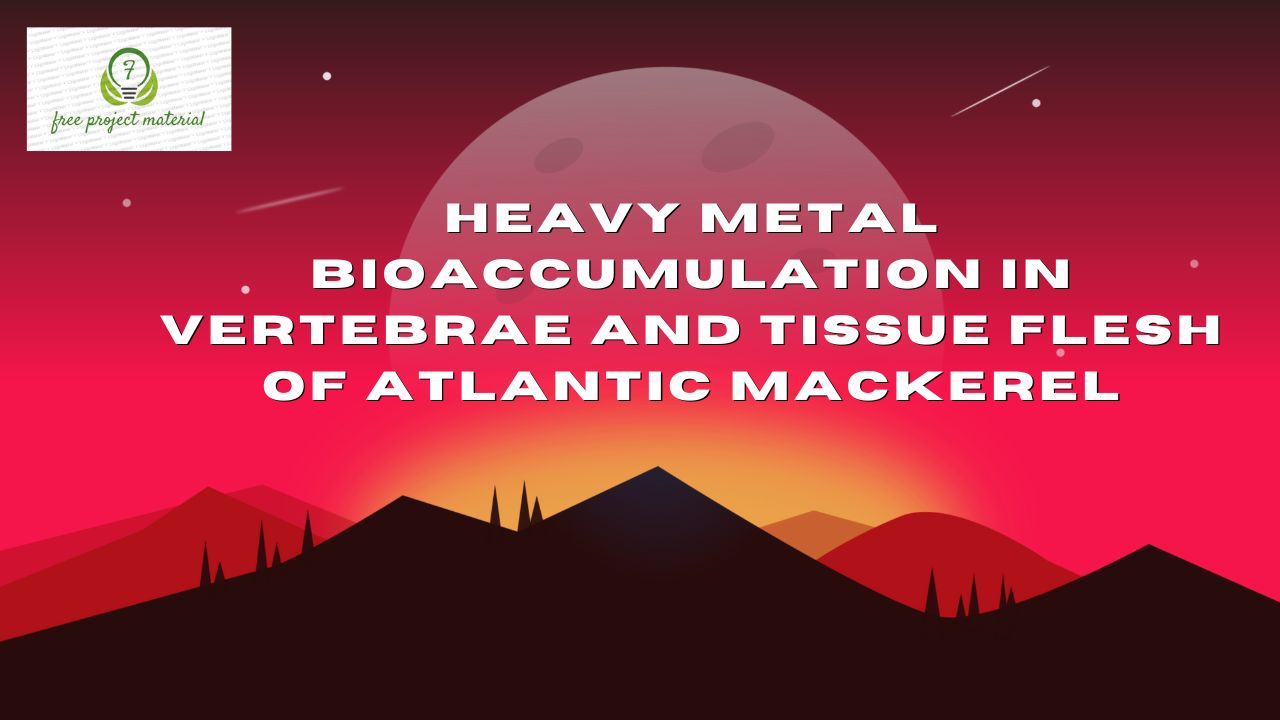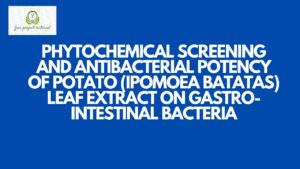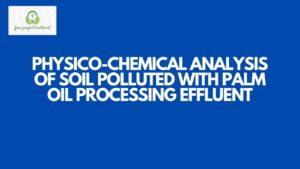ABSTRACT
Heavy metals bioaccumulation in vertebrae and tissue flesh of Atlantic mackerel (Scombia scombrus) were investigate with standard analytical procedures. The vertebral bone recorded Lead (Pb) (0.016 ± 0.002), Cadmium (Cd) (<0.001 ± 0.000), Nickel (Ni) (0.035 ± 0.002), Chromium (Cr) (0.05 ± 0.002), and Zinc (Zn) (0.153 ± 0.002). The tissue flesh revealed for Lead (Pb) (0.009 ±0.001), Cadmium (Cd) (<0. 001 ± 00.000), Nickel (Ni) (0.012 ± 0.002), Chromium (Cr) (0.006 ± 0.001) and Zinc (Zn) (0.044 ± 0.002). The mean values of metallic element investigated were below the allowable limits of WHO (2004); indicating the fish samples were not the contaminated and therefore the suitable for human consumption. However, the levels of toxic elements in fishes severally depend on the fish sex, age, season and location. Treatment of all kinds of waste waters, sewage and agricultural discharge should be ensured before disposal into the aquatic systems in order to maintain good quality of inland waters and preserve the inhabitants.
TABLE OF CONTENTS
Title page – – – – – – – – – i
Certification – – – – – – – – ii
Dedication – – – – – – – – – iii
Acknowledgement – – – – – – – iv-v
Abstract – – – – – – – – – vi
Table of Contents – – – – – – – – vii-ix
CHAPTER ONE: INTRODUCTION
1.1 Background of the Study – – – – – – 1-3
1.2 Aim and Objectives of the Study – – – – – 3
1.3 Scope and Limitation of the Study – – – – 4
1.4 Definition of Terms – – – – – – – 4-5
CHAPTER TWO: LITERATURE REVIEW
2.1 Life History of Atlantic Mackerel – – – – 6-10
2.2 Reproduction – – – – – – – – 10-13
2.3 Food Habits – – – – – – – – 13-16
2.4 Habitat Characteristics – – – – – – 16-23
2.5 Heavy Metals and Health Effects – – – – – 23
2.5.1 Lead (Pb) – – – – – – – – 23-24
2.5.2 Cadmium (Cd) – – – – – – – 24-26
2.5.3 Nickel (Ni) – – – – – – – – 26-27
2.5.4 Chromium (Cr) – – – – – – – 27-28
2.5.5 Zinc (Zn) – – – – – – – – 29-31
CHAPTER THREE: MATERIALS AND METHOD
3.1 Materials and Reagents – – – – – – 32-33
3.2 Method of Sample Collection – – – – – 33-34
3.3 Wet Digestion of Sample for Heavy Metal Analysis – 34-35
3.4 Determination of Heavy metals in fish samples using AAs – 35
CHAPTER FOUR: RESULT AND DISCUSSION
4.1 Results – – – – – – – – – 36
4.2 Discussion – – – – – – – – 37-38
CHAPTER FIVE: CONCLUSION AND RECOMMENDATION
5.1 Conclusion – – – – – – – – 39
5.2 Recommendations – – – – – – – 39-40
References
CHAPTER ONE: INTRODUCTION
1.1 Background of the study
According to Berkley (2012) some 85 percent of the seafood Americans consumes is imported and much of that is farm- raised in Asia and elsewhere in the developing world where fish farms are not inspected by U.S. officials and only a fraction of imported seafood is actually tested for drug residues when it enters the country.
According to a report captioned importing bad news the food and Drug Administration (FDA) choices just two percent of imports for contaminates (including drug residues, microbes, and heavy metals), compared to 20 to 50 percent in Europe, 18 percent in Japan and up to 15 percent in Canada. And when the FDA does inspect seafood imports, it took for residues from only 13 drugs. In contrast, Europe tests for 34 drugs. That means overseas fish farms can be using a range of drugs for which the U. S. doesn’t even screen the European (EU) is the dominant supplier of frozen seafood products with more than 70% of market share in Nigeria. Other supplying countries include china, Korea, Brazil, Paraguay, Uruguay, USA, Gambia, Mauritania, Namibia, Angola and Morocco.
Imported frozen seafood is usually shipped to Apapa- Lagos, Port Harcourt and Warri are inspected, passed through custom clearance. After clearance the products are transported in refrigerated trucks to cold storage warehouse located within Lagos and other urban centers. Imported seafood products are shipped in branded boxed packages of 20kg, 25kg and 30kg and the number of fish per box varies with fish sizes- small, medium or large which range from 80 to 120 pieces for carton. The threat of toxic and trace metals in the environment is more serious than those of other pollutants due to their non-bio-degraolable nature, accumulative properties and long biological half-lives. It is difficult to remove them completely from the environment once they enter into it Aderinola et al., (2009).
Heavy metal contamination may have devastating impacts on the ecological balance of natural water bodies including the loss of aquatic diversity (Vasyliene and Jankaite (2006). Farombi et al. (2007). Hayat and Javed. (2008). with increased use of a wide variety of metals in industries and in our daily life, there is now a greater awareness of toxic metal pollution of the environment. Many of these metals tend to remain in the ecosystem and eventually move from one compartment to the other within the food chain (Sadasivan and Tripathi (2001).
1.2 Aim and objectives of the study
The aim of this work is to determine heavy metals concentration Atlantic mackerel in (Scombia scombrus) sold in Akpan Andem daily market in Uyo in order to ascertain the safety of its consumption.
The objectives of this research therefore include:
(i) Evaluation of Heavy metals Bioaccumulation in vertebrae and tissue flesh of Atlantic mackerel Scombia scombrus fish sold in Akpan Andem daily market in Uyo.
(ii) Comparison of doses of heavy metals in the vertebrae and tissue flesh of Atlantic mackerel.
1.3 Scope and Limitation of the study
The research project was designed to evaluate Heavy metal bioaccumulation in vertebrae and tissue flesh of Atlantic mackerel (Scombia scombrus). This was done by analyzing the fish samples and their proximate contents. Poor finances limited the scope of this research work.
1.4 Definition of terms
Heavy Metals: May be defined as metallic chemical elements that have a relatively high density in toxic at low concentration. Example; Mercury (Hg), Cadmium (Cd), Arsenic (As), Chromium (Cr), Thalium (Ti) and Lead (Pb).
Bioaccumulation: Is the gradual accumulation of substances, such as pesticides or other chemicals in an organism. Or Bioaccumulation occurs when an organism absorbs a substance at a rate faster than that at which the substance is lost.
Vertebrae: May be defined as any of the bones or segment composing the spinal column, consisting typically of cylindrical body and an arch with various processes and forming a foramen or opening through which the spinal cord passes.
Tissue: Is a group of cells that have similar structures and that function together as a unit. There are four main tissue types in the body epithelial, connective muscle and nervous.
Flesh: Is the soft parts of the body of any animal and especially of a vertebrate parts composed chiefly of skeletal muscle.
Atlantic Mackerel: These are a small, abundant forage fish that live across the northern atlantics. OR These are a marine fish found on both sides of the Atlantics Ocean.


